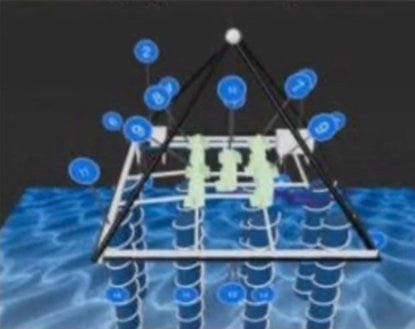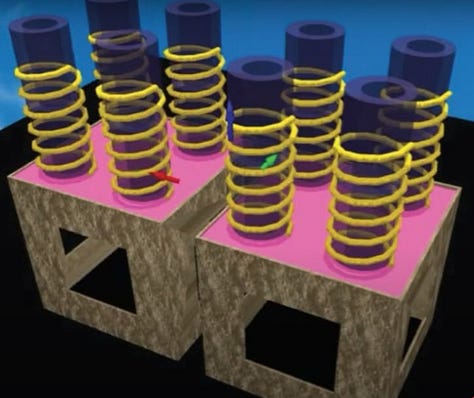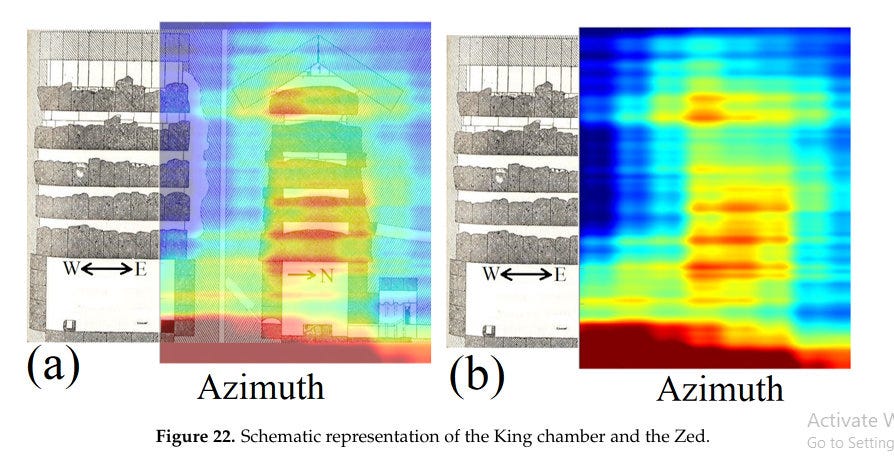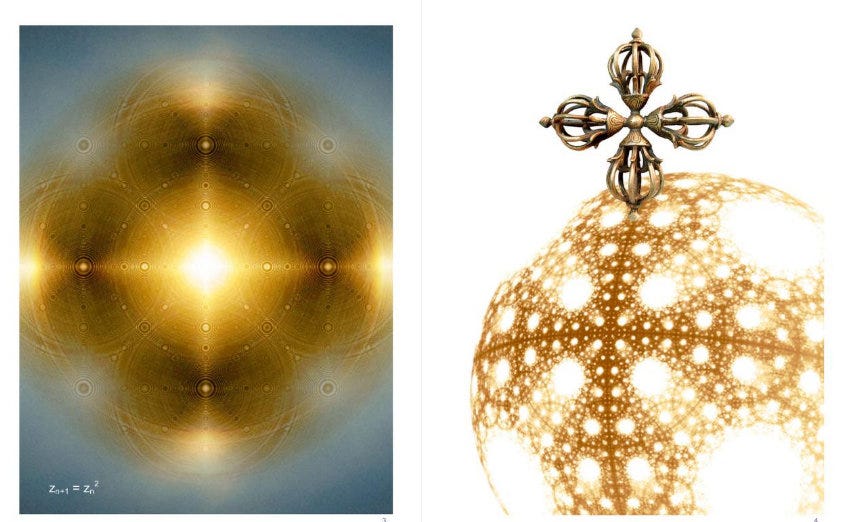Beneath the Khafre Pyramid is a 2-Kilometer Enigma
A groundbreaking discovery has just sent shock waves through the worlds of archaeology, science, and esoteric speculation
Advancements in technology are igniting a revolution in our understanding of ancient civilizations, unraveling mysteries that challenge the very foundations of human history. With each groundbreaking discovery, the textbook narratives of our past are shattering faster than we can comprehend, demanding a radical rewriting of the human story which may bring us much closer to the cosmos.
From the depths of the Giza Plateau to the emerald heart of the Amazon, we are uncovering phenomenal truths that are reshaping our understanding of human evolution, illuminating our consciousness, and revealing celestial bonds.
A global network of pyramids, once thought to be isolated monuments, emerges as a cosmic jigsaw puzzle, each piece whispering secrets of a forgotten unity across the Earth, through the ages. Over the past few years, I shared some exciting discoveries made with LiDAR technology, which pierced the Amazon’s dense canopy, unveiling sprawling pyramid cities surrounded by ancient savannas. These ancient urban echoes, once the vibrant heartlands of Bolivia’s Casarabe culture from 500 to 1400 CE, thrived across 32 square miles before the rainforests reclaimed the land, sprouting from abandoned fruit trees after Spanish colonization. This revelation shatters the myth of the Amazon as an untouched rainforest that had evolved for thousands of years, exposing a vastly different story of dramatic environmental changes in the ecological landscape, impacted by a forgotten complex civilization. A legacy so profound, it leaves one to wonder if the indigenous forest keepers we know today, are the remaining descendants of those lost ancient pyramid cities, which are now being identified by scientists using LiDAR technology across the Amazon from Brazil to Bolivia.
Transitioning from the lush green rainforests of South America to the arid desert landscape of the East, we arrive at the Giza Plateau. A timeless sentinel of Egypt’s ancient glory, has long held secrets beneath its shroud of sand and silence. For centuries, the pyramids, Khufu, Khafre, and Menkaure, have stood as cryptic beacons, their mysteries locked within stone.
On March 16th, 2025, a press conference was held in Bologna, Italy to announce the findings of the Synthetic Aperture Radar (SAR) scan technology used by scientists on the Khafre Pyramid at the Giza Plateau; this research has been ongoing since 2022. This cutting-edge method enabled the 3D reconstruction of internal underground structures of the Khafre Pyramid, revealing details that were previously invisible to traditional methods. The research team, led by Corrado Malanga from the University of Pisa and Filippo Biondi from the University of Strathclyde, revealed the discovery of massive underground structures beneath the pyramid. A staggering discovery, unveiling a subterranean realm at depths that defy comprehension, as it shatters the rigid dogma of archaeology, inviting new visions of the pyramids’ purpose and creation.
The Press conference unveiled revelations that echo through the ages, which will change the entire perspective on the Pyramids of Giza. Near the Khafre Pyramid’s ancient base, the team’s SAR gaze pierced the earth to reveal five towering cylindrical structures, their identical forms a symphony of precision, bound by geometric pathways that hum with intent. These shadowed sentinels plunge deep beneath the plateau, their depths a mystery that defies the mortal coil, many ancient historians and alternative energy scientists theorized over the Pyramids as conduits of cosmic energy or pathways to Thoth’s hidden secrets. Since their last findings were published using SARS in 2022, the research team are dedicated to non-invasive exploration, carving luminous trails into the past using cutting edge scientific methods, promising to unveil the secrets of ancient civilizations.
The 2022 paper revealed a revolutionary method: transforming SAR data into phononic signals, capturing millimetric frequencies, sometimes from background seismic waves—to create high-resolution 3D images. They turned their gaze to Khafre using this technique, using proprietary software, and data from satellites above, each radar pulse a curious explorer frequency dancing with ancient stone.
A labyrinthine network plunges 2 kilometers beneath the Khafre Pyramid, threading beneath Giza’s iconic triad in a symphony of shadow and wonder. Here, history is not merely etched, it sings a revelation that stirs the soul, hinting at lost libraries, emerald wisdom, and a sanctified refuge tied to the legends of the Emerald Tablets and Thoth, seen by many as the divine scribe and keeper of cosmic lore. Could this hidden underworld be the key to an ancient knowledge repository, or the rejuvenation site that Thoth retreated to or the secret power generator of the pyramids themselves?
Alex Putney wrote in his book Human Resonance- Akasha ‘‘the Ancient Atlantean Pyramids were designed to create the same effects as a giant tree, which informs the ancient spiritual metaphor for the cosmic energy structure as a giant tree of life’’.
He goes on to explain fruit will not desiccate in the Great Pyramid Chambers, and Guru’s bodies will not desiccate when placed in the resonant niches of the sacred temple, where bioelectrical energy is ambiently focused for human physical and spiritual benefit.
The revelations are breathtaking. Vertical wells with spiral structures on the outside, plunging perhaps 648 meters into the earth, like a giant ancient Egyptian version of Tesla Coils which then connect to monumental cubic chambers; each an imposing 80 meters wide—loom as silent cathedrals, while pathways stitch these wonders together into a network that descends 2 kilometers below.



In 1997, John Stuart Reid’s cymatics experiments in the Great Pyramid of Giza revealed intriguing patterns when he stretched a membrane over the sarcophagus, activated by sound, the cymatics patterns that emerged resembled hieroglyphs and suggested the ancient Egyptians used vowel chants in rituals within the highly reverberative King’s Chamber. During these tests, Reid, who had suffered from severe back pain, found it permanently relieved after 20 minutes of acoustic work, sparking his exploration into sound’s healing potential. The chamber’s acoustics, acoustically coupled with the sarcophagus, hint at intentional design for ritual or therapeutic purposes. Reid’s research, detailed in Egyptian Sonics, extends to sound therapy, distinguishing healthy cell sounds from cancer cells, underscoring sound’s role in natural healing.
Reid conducting cymatics experiments in the Kings Chamber.
These Resonance Chambers, speculatively tied to rejuvenation rituals and advanced technology, echo the theories proposed by The Giza Power Plant by C. Dunn (1998), which suggests the pyramids as energy-generating machines. This idea finds further resonance in J.P. Farrell’s The Giza Death Star (2001), which explores the pyramids as advanced technological constructs, potentially linked to power generation. Visionaries like Christopher Dunn and Joseph Farrell see the pyramids as energy machines; now, with wells tapping unseen depths, the dream takes root.
Ancient Egyptian traditions tell us of the god Thoth, who wielded immense wisdom and mastery over life and death. Could these underground chambers, hidden for millennia, have been connected to the god’s sacred knowledge? Speculation arises that these sites may have served as rejuvenation sanctuaries, echoing the teachings of the Emerald Tablets of Thoth, with their promise of eternal life and wisdom.
Moreover, these discoveries align with the hypotheses of scholars like Graham Hancock, whose book Fingerprints of the Gods (1995) suggests that an advanced lost civilization may have constructed the pyramids, proposing a deep connection between the ancient structures and Earth’s energetic grid. The discoveries beneath the Khafre Pyramid continue to fuel such theories, hinting at technologies far beyond what we currently understand.
My experience in 2018 of dowsing at the Huaca Pucllana pyramid in Peru, Lima revealed the presence of powerful energy waves or frequencies radiating from the pyramid’s core. These waves extend far beyond the pyramid, reaching the surrounding areas and even upward into the ionosphere. Using metal rods to sense these energies, the dowsing practice detects and respond to natural wave frequencies and aetheric energy—sometimes referred to as electromagnetic patterns—this suggests the Huaca was intentionally constructed on a geologically or energetically significant site. I dowsed the edges of the pyramid and also areas on the Huaca Pucllana Pyramid. It is one of the most prominent of these ancient adobe pyramids.
A pre-Inca ceremonial and administrative center was built by the Lima culture between 200 and 700 CE. The structure, made primarily of adobe bricks, rises in a stepped pyramid design, echoing the cosmic symbolism often attributed to pyramidal structures worldwide. The Energetic Frequencies of Huaca Pyramids —These energy fields likely served the ancient cultures for spiritual ceremonies, healing rituals, and perhaps as a means to connect with otherworldly realms, hinting at a lost understanding of resonance frequencies and technological knowledge. These structures were deliberately constructed to align with celestial movements, harness and amplify natural energy flows, and believed to optimize spiritual and cosmic connections.
Source
In contrast to Lima’s adobe resonance pyramids— evidence of granite working in ancient Egypt first appears around 3900 BC at Nekhen, a full 1,400 years before the Great Pyramid’s construction circa 2500 BC—ample time for Egyptian engineers to develop an understanding of acoustics. This raises the question: what motivated their efforts to master the acoustic environment? Is it the motivation to connect with the spirit realm during sacred rituals or is it also to harness the Earth’s natural energy for other purposes, a pursuit that would have shaped their architectural and sonic innovations.
The Great Pyramid of Giza, though not wholly clad in granite, weaves this stone into its sacred core. Its outer shell once gleamed with fine white Tura limestone, drawn from quarries across the Nile, prized for its polished sheen. Yet within, particularly in the King’s Chamber, a striking red granite from Aswan was used, sourced some 800 kilometers south. Known as Aswan granite or syenite, its rosy tint, born of feldspar, is flecked with dark quartz and hornblende, lending both strength and beauty, but perhaps also selected for its resonance properties.
Here, massive blocks, some weighing 50 tons, shape the chamber’s walls, ceiling, and beams, while the sarcophagus itself is hewn from a single slab of this enduring stone—a testament to the Egyptians’ mastery over quarry and river, did they also use resonance technology they had below the pyramids to help them move these colossal stones?
Though local Giza limestone forms the pyramid’s vast body, the deliberate placement of Aswan granite in these hallowed spaces speaks to its dual role: a bulwark of structure and a symbol of the divine.
‘‘So once again we have Mathematics in Stone, where the sharing of knowledge is done via means that are hard to casually destroy. It is just a matter of realising that there is more going on than an empty chamber and sarcophagus. It is such a pity that Egyptologist refuse to look at this evidence objectively. Apparently prevailing re ligious beliefs in Egypt dictate a given time-line, and anything that challenges that time-line is simply ignored or dismissed as “co-incidence”. How many 𝜋 ratios does it take to convince someone that either Giza is not 4th dynasty, or if it is, then the history of mathematics is wrong? If Giza is not 4th dynasty, then when was it built?’’ -Ian Douglas , (2023).
In Giza, Thoth’s legacy might pulse through granite and sand. In Peru, Huaca Pucllana’s adobe amplifies the Earth’s pulse, a sacred playground where the Lima culture dances with cosmic forces. In the Amazon, Pyramid cities and reservoirs stand as silent witnesses to people who bent nature to their will. Each site, from desert to jungle, whispers of a past where humanity reached for the stars—perhaps not just in spirit, but in practice. Meanwhile, the Pyramids of Giza hold the biggest secret that may reveal clues to what connects the global network of pyramids around the world, were they all built with the common intention to amplify the Earth’s natural Aether and telluric fields?
Conclusion
The Khafre Pyramid, is more than a burial chamber, it may be a Rejuvenating Energy Generating Resonance Chamber, humming with ancient rites, and deep pathways binding a subterranean triad, Khufu, Khafre, Menkaure, into a single, resonant frequency, that sends out a powerful telluric field across the Planet and may have some primordial sacredness connected to Schuman’s Resonance, the Earth’s Natural Pulse and Planetary Aetheric Electromagnetic Fractal Energy.
Image source- Human Resonance Project Akasha-Alex Putney
The SAR scan of the Khafre Pyramid, evolved from Malanga and Biondi’s 2022 research, unveiled remarkable deep subterranean structures, beneath the Giza Plateau, that defy all scientific or historic, explanation— pushing the boundaries of earlier documented studies.
While the 2022 findings are well-established and widely available, these latest discoveries stem from a press conference held in Italy earlier this month, leaving us in eager anticipation of the forthcoming official report and paper. This news promises to be a transformative milestone, reshaping humanity’s pursuit of lost knowledge and marking a shift in consciousness, as it challenges us to reconnect with lost knowledge of aetheric science, telluric energy systems, and the potential existence of cosmic kin, each demanding a profound shift in our collective understanding.
by
Further References
Biondi, F., & Malanga, C. (2022). Synthetic Aperture Radar Doppler Tomography reveals details of undiscovered high-resolution internal structure of the Great Pyramid of Giza. Remote Sensing, 14(20), 5231. https://doi.org/10.3390/rs14205231
(Note: This is the foundational peer-reviewed paper detailing the SAR methodology used for the Great Pyramid, underpinning the 2025 Khafre scan.)
Douglas, I. (2023). A preliminary analysis of the unexplored Great Chamber in the Great Pyramid. In History of Mathematics: The Great Pyramid, Pyramid of Giza. https://doi.org/10.5281/zenodo.8247385
Dunn, C. (1998). The Giza Power Plant: Technologies of Ancient Egypt. Bear & Company.
(This book proposes the pyramids as energy-generating machines, relevant to the rejuvenation chamber speculation.)
Farrell, J. P. (2001). The Giza Death Star. Adventures Unlimited Press.
(This work explores the pyramids as advanced technological constructs, supporting energy generator theories.)
Hancock, G. (1995). Fingerprints of the Gods: The Evidence of Earth's Lost Civilization. Crown Publishers.
(Hancock’s book suggests a lost advanced civilization built the pyramids, aligning with alien origin and energy grid hypotheses.)
Sitchin, Z. (1976). The 12th Planet.
(Sitchin's work explores ancient astronaut theory, proposing that extraterrestrial beings influenced early human civilization, which some connect to the pyramids and their origins.)
Khafre SAR Scan March 2025 Youtube
The Caves Entrance to the Underworld Youtube
Richard Gabriel & Trevor Grassi





